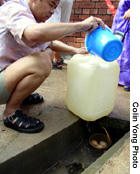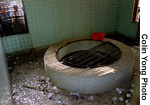Singapore Sling
Spring time in Singapore
By Rennie Loh
|
|
空軍基地内の温泉が人気
 |
|
温泉の入り口には、湧き出る温泉を容器に入れて持ち帰る人や足をぬらす人が行列をつくる。
|
|
Singapore's best kept secret might be a remote hot spring spot in Sembawang, north of the island. A few months ago, the area around the spot was serene, neglected and surrounded by tall undergrowth, where the only visitors were forest animals.
 Then construction began to transform the area into part of Sembawang Air Base, a military facility. The surrounding land was flattened, and a trail was blazed into the heart of the forest, leading right to the spring. Word of this attraction is out, and droves of people have been visiting the spot.
Then construction began to transform the area into part of Sembawang Air Base, a military facility. The surrounding land was flattened, and a trail was blazed into the heart of the forest, leading right to the spring. Word of this attraction is out, and droves of people have been visiting the spot.
My friend Colin and I were drawn to this epicenter of activity on a warm Sunday afternoon. Many families, both young and old, were there already, with more making a beeline for the hot spring through the narrow fence at the entrance. Unlike us, they had come well-prepared, with stools and water receptacles.
When we reached the spot, we saw people busily filling up containers of hot natural spring water from a flowing tap and scooping from a drain nearby. Despite the water's sulfureous smell, some had even brought eggs and placed them in the drain, expecting to have a meal within an hour.
 Many middle-aged men and women were blissfully soaking their feet in pails of hot spring water, which they believed could rid them of aches and pains. Some others were pouring the water into bottles and pails to take home.
Many middle-aged men and women were blissfully soaking their feet in pails of hot spring water, which they believed could rid them of aches and pains. Some others were pouring the water into bottles and pails to take home.
Lee Ah Huay, a woman in her 50s, said, "I heard the water cures rheumatism and improves blood circulation. This is my third visit and I am feeling better." Another visitor, Tan Beng Huat, in his 40s, who was soaking his feet, declared, "It is very shiok (Singlish for great)! It is better than going to the sauna."
According to some old newspaper records, the hot spring was one of four discovered in the area in 1909 by Chinese merchant Seah Eng Keong. Three were sealed up to concentrate the water flow into one outlet.
In those early years, the village in the hot spring area was named Kampong Ayer Panas, which means hot water village. A well from which the spring bubbled was also erected and became the focal point of village communal activities. Today, the well is locked within a dilapidated hut at the hot spring site. With coins and dollar notes around it, it seems that many people have likened it to a wishing well.
In 1922, a beverage manufacturer bought the land and built a factory nearby to bottle the mineral water from the spring. The activities were interrupted when a bomb fell near the well during an air raid in 1944. During the Japanese occupation, a number of thermal baths were built in the area by the Japanese forces so that they could relax in the warm water while enjoying its curative effects. In the '60s, superstitious punters were known to flock there to scrub off the grime of bad luck before they went to the horse races.
In 1965, perhaps prompted by the nation's declaration of independence and the presence of British forces, the beverage manufacturer announced that it would develop the area into a spa and health resort modeled after those in Europe, complete with hot spring baths, a swimming pool, a golf putting green and rest areas.
Unfortunately, this multimillion-dollar spa venture was aborted, but its water-bottling plant, which stood adjacent to the spring, survived into the early 1990s. The land was then handed over to the Ministry of Defense in 1985, which wanted it in reserve for future air base development.
It is quite unimaginable, but in some parts of Singapore, there are actually volcanic rocks lying deep below the ground. Associate professor Wong Poh Poh of the National University of Singapore's geography department explained how hot springs were formed, "Water gets heated up as it flows above the volcanic rocks and after some time, the pressure of the boiling water may force it out of the ground."
Unlike the islands of Japan, which are blessed with a natural abundance of rumbling, underground thermal activity, and centuries of tapping this resource has created one of Japan's greatest pleasures — onsen, hot springs in Singapore are practically unheard of and hence, not explored and developed.
The fate of this age-old hot spring site remains unclear. Many visitors want the area conserved or developed into a health and recreational hot spot. Meanwhile, before the government comes down hard to fence off the area from the public, Singaporeans are not missing any opportunities to soak from this well of bubbling hot spring water.
Shukan ST: March 1, 2002
(C) All rights reserved
|




 Then
Then  Many
Many